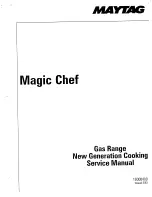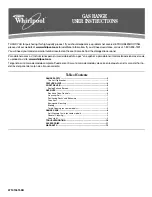
12
Check these points if . . .
Part or all of appliance does
not work.
•
Check to be sure plug is securely in-
serted into receptacle.
•
Check or re-set circuit breaker. Check or
replace fuse.
•
Check power supply.
•
Check if surface and/or oven controls
have been properly set. See pages 4-7.
Surface burner fails to light.
•
Check to be sure unit is properly con-
nected to power supply.
•
Check for a blown circuit fuse or a tripped
main circuit breaker.
•
Check to be sure burner ports or ignition
ports are not clogged. See page 4.
•
Check to be sure ignitor is dry and click-
ing. Burner will not light if ignitor is
damaged, soiled or wet. If ignitor doesn’t
click, turn control knob
Off
.
The flame is uneven.
•
Burner ports may be clogged.
Surface burner flame lifts off
ports.
•
Check to be sure a pan is sitting on the
grate above.
Baking results differ from
previous oven.
•
Temperatures often vary between a new
oven and an old one. As ovens age, the
oven temperature often “drifts” and may
become hotter or cooler.
Baking results are not what
you expected.
•
Check the oven temperature selected.
Make sure oven is preheated when recipe
or directions recommend preheat.
•
Check rack positions. See page 8.
•
Use correct pan. Dark pans produce dark
browning. Shiny pans produce light
browning. See
“Cooking Made Simple”
booklet for more information on
bakeware.
•
Check the use of foil in the oven. Never
use foil to cover an entire oven rack.
Place a small piece of foil on the rack
below the pan to catch spillovers.
•
Check pan placement. Stagger pans when
using two racks. Allow 1–2 inches be-
tween pans and oven walls.
•
Make sure the oven vent has not been
blocked. See page 8 for location.
•
Check to make sure range is level.
Food not broiling properly.
•
Check oven setting. See page 7.
•
Check rack positions. See page 7.
•
Aluminum foil was incorrectly used.
Never line the broiler pan insert with foil.
Before You Call for Service
Oven smokes excessively
during broiling.
•
Food too close to flame. See page 7 for
more information.
•
Broiler insert covered with aluminum
foil.
•
Excess fat not trimmed from meat prior
to broiling.
•
A soiled broiler pan was used.
Moisture condensation
collects on oven window.
•
This is normal when cooking food high
in moisture.
•
Excessive moisture was used when clean-
ing the window.
Strong odor or light smoke
occurs when oven is turned
on.
•
This is normal for a new range and will
disappear after a few uses. Opening a
window or turning on a fan will help
remove the smoke and odor.
•
Excessive food soils on the oven bottom.
Summary of Contents for WT-TOD
Page 43: ...42 Notas ...














































